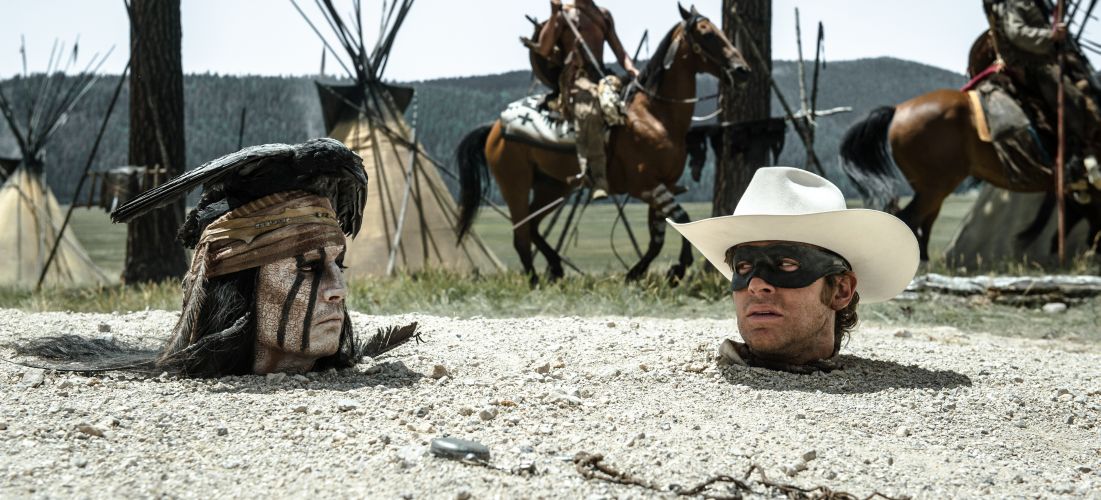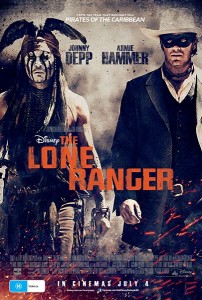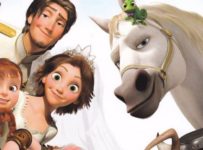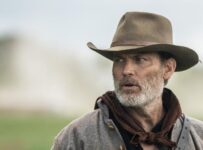Hi-ho Silver, the Lone Ranger is away again! These ain’t yer daddy’s cowboys, as Gore Verbinski brings a little bit of Sparrow to the Old West.
[stextbox id=”grey” caption=”The Lone Ranger (2013)” float=”true” align=”right” width=”200″]
Director: Gore Verbinski
Writer: Justin Haythe, Ted Elliott, Terry Rossio
Runtime: 149 minutes
Starring: Johnny Depp, Armie Hammer, Tom Wilkinson, William Fichtner, Barry Pepper, Ruth Wilson, James Badge Dale, Helena Bonham Carter
Distributor: Disney
Country: US
Rating: ★★★½
More info
[/stextbox]
Gore Verbinski had an unexpected hit for Disney with Pirates of the Caribbean: The Curse of the Black Pearl, birthing the highly imitable Captain Jack Sparrow (in the guise of Johnny Depp). As the star and his rum soaked creation gradually merged into the same person over the next three sequels, Verbinski cut loose to quietly master animation with the superb Rango. With The Lone Ranger, both star and director come full circle to transplant their winning formula from the high seas to the Old West, reviving the the 1930s radio serial and the arguably better known 1940s/50s TV series with Clayton Moore and Jay Silverheels as the titular ranger and his trusty sidekick Tonto.
In the latest film version, a young boy encounters an aged Tonto (Johnny Depp) in a carnival sideshow in 1933. The strange native, still wearing a dead crow on his head, recounts the tale of how he first encountered John Reid (Armie Hammer), the man that would become The Lone Ranger. As they both pursue the outlaw Butch Cavendish (William Fichtner), they become embroiled in the dealings of railroad tycoon Latham Cole (Tom Wilkinson).
The troubled production comes bursting onto the screen with the literal momentum of a runaway freight train. Opening with a massive action sequence that seems impossible to top, but does anyway, Verbinski takes the same rollicking approach that made the Pirates of the Caribbean films so successful. Like The Green Hornet, another radio serial with familial ties to The Lone Ranger, this adaptation plays partly for laughs, but errs on the side of adventure. It’s this take, from Pirates and Shrek co-writers Ted Elliot and Terry Russo, along with Revolutionary Road‘s Justin Haythe, that gives this big-budget Western a much needed dose of fun. Cutting out some of the early draft indulgences of werewolves and other supernatural nasties, Verbinski has effectively remade Pirates of the Caribbean – and this isn’t necessarily a bad thing.
More worrying is Depp’s portrayal of Tonto, a character whose pidgin language has long been held as a degrading depiction of Native Americans. Depp’s protestations that he is of Native American origin have been used to justify his “red face” performance, but it is nevertheless as stereotypical as the versions that have come before. His quirky behaviour is essentially Jack Sparrow by any other name, and the reason for his anachronistic behaviour is half-heartedly explained by a plot twist concerning his character later in the film. Nevertheless, a golden opportunity was missed to right the wrongs of the past, and instead Depp played Tonto for laughs, a mixture of his own famous role and a New Romantic musician of the 1980s.
Yet The Lone Ranger is a roller coaster ride, and paying attention to the details will only give you eye strain and the potential for whiplash. Despite the bloated running time, it never drags its feet for too long, and its only real crimes are excess. Hammer is a capable hero, and we get to watch him grow into the role over the course of the film, and box office success willing, several more to come. Filled with sight gags, massive set pieces and killer bunnies, it’s the kind of silly fun that is sorely needed in an increasingly darkened cinema, and a welcome return to a bygone era of Westerns.
The Lone Ranger is released in Australia on 4 July 2013 from Disney.





